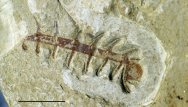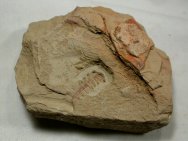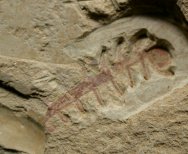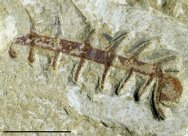Hallucigenia fortis
Geological Time: Lower Cambrian (~525 million years ago)
Size: Hallucigenia is 18 mm long
Fossil Site: Chengjiang Maotianshan Shales, uiongzhusi Section, Yu’anshan Member, Heilinpu Formation, Mafang, Anning, Yunnan Province, China
|
The
Lobopodians are small marine and terrestrial animals termed colloquially
“velvet worms” or “worms with legs”. While
all Recent forms are terrestrial, most fossil Lobopodians are marine,
and are The genus was first discovered in the slightly younger Burgess Shale of Canada (Hallucigenia sparsa), and was interpreted as walking on its spikes, rather than the legs as is quite obviously the case (perhaps the source of the genus name?). It is thought to be most closely related to Microdictyon, and may possibly be known from the Kaili Biota as well. Also see: Chengjiang Biota, Chengjiang Fossils, Cambrian Explosion |





